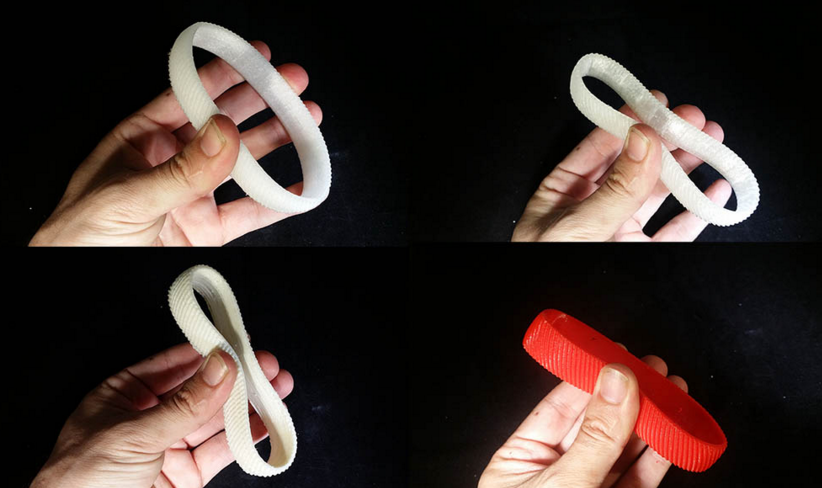 In the area of 3D printing, where new products and materials are emerging continually, one must be very thankful for those taking the time to test items for us, saving us hours, effort, and many potentially wasted dollars. In a recent review from SD3D, in a blog by Sean Aranda called Meet the Flexibles: An Expansive Review of 3D Printing Flexible Materials, we are able to learn a great deal more about four flexible filaments:
In the area of 3D printing, where new products and materials are emerging continually, one must be very thankful for those taking the time to test items for us, saving us hours, effort, and many potentially wasted dollars. In a recent review from SD3D, in a blog by Sean Aranda called Meet the Flexibles: An Expansive Review of 3D Printing Flexible Materials, we are able to learn a great deal more about four flexible filaments:
- PCTPE from taulman 3d
- FlexSolid from MadeSolid
- NinjaFlex by NinjaTek
- Cheetah by NinjaTek
It’s important to note that there are of course many other flexible filaments on the market; however, it’s just as important to note that these happen to be materials that the SD3D team works with regularly. For these testing purposes, they used LulzBot TAZ5 printers with e3D hotends.
In the SD3D review, things are looking pretty good right off the bat for PCTPE, as they refer to it as ‘amazing material.’ Formally known as Plasticized Copolyamide Thermoplastic Elastomer, you should find that this material offers you all the benefits associated with elastomers, combined with the durability of nylon. Specifications are: strength: 5046 PSI, elongation: 497.6%, Tg: 74C.
“The interlayer adhesion of PCTPE is excellent which is what makes this elastomer the most durable of any we have tested to date,” states the SD3D team in their review.
Pointing out that while the elongation for PCTPE is very impressive at nearly 500%, you may be interested to realize that it is the least flexible of the four filaments being reviewed, and does offer rigidity as well, displayed in resistance as they tried to bend the 3D printed bracelet in half. All of these features should lead to be a better 3D printing experience, and SD3D predicts that you will be able to print more expediently with normal retraction settings. With Ninjaflex and FlexSolid, you may not experience the speed in fabrication.
“Since there is plenty of bend before breaking with PCTPE, but still rigid enough to maintain its shape, this material works great on any mechanical part that vibrates or requires cushioning,” states SD3D in their review. “PCTPE comes in a standard white color but can be dyed as any nylon based material can.”
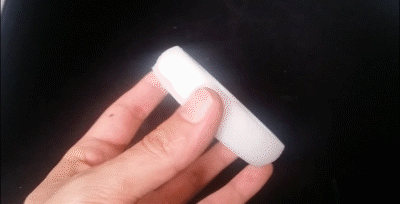 Because of the balance between rigidity and flexibility, the SD3D team recommends this filament for items like phone cases. In terms of printer settings, while this is an easygoing material to work with, be warned that you will need to worry about the more common issues of adhesion to the print bed, along with warping. If you’d like to ward off any issues, SD3D passes on their expertise to you: try applying one coat of PVA to a 45°C glass bed in order to eliminate sticking to PEI. The mixture for your coating should be eight parts water to one part standard glue. While you may still see warping here and there, with this process you should have pretty good luck.
Because of the balance between rigidity and flexibility, the SD3D team recommends this filament for items like phone cases. In terms of printer settings, while this is an easygoing material to work with, be warned that you will need to worry about the more common issues of adhesion to the print bed, along with warping. If you’d like to ward off any issues, SD3D passes on their expertise to you: try applying one coat of PVA to a 45°C glass bed in order to eliminate sticking to PEI. The mixture for your coating should be eight parts water to one part standard glue. While you may still see warping here and there, with this process you should have pretty good luck.
With PCTPE, you can look forward to printing at 45mm/s, and operating at up to 55° without requiring any support material. If you are using supports, it’s recommended that you set the angle required set to 52°, with a fill amount of 10%. As SD3D did, you may want to increase the distances for support from PLA to 0.8mm in the X/Y direction and 0.16mm in the Z axis.
“This seems to work quite well, but complex models will still give you a tough time,” stated the team.
 You should also use the following settings:
You should also use the following settings:
- Minimum travel for retraction at 1.5mm
- Combing type to ‘all’
- Minimal extrusion before retracting at .005mm
- Z hop when retracting to 0.1mm
- Speed to 10mm/s
- Distance to 1.5mm
“PCTPE was the first flexible filament we enjoyed printing,” states the SD3D team. “We instantly began printing phone cases, bracelets, other wearable items since it was so much smoother and softer than the average PLA or ABS.”
“This product is also great for parts that require brace impact or have a lot of vibrations since it holds its shape much better than the other three materials listed. While it definitely has its applications, we seem to find ourselves using FlexSolid more frequently.”
And with that said, let’s check out what more they had to say about FlexSolid! Another ‘amazing’ material—this elastomer is said to be very close to rubber, so keep that in mind regarding your project requirements. With less elongation than PCTPE, you will find it to be softer and more flexible—and able to print at higher speeds. Specifications are: strength: 7250 PSI, elongation: 450%, Tg: 74C.
It’s also important to take into account that these experienced 3D printing enthusiasts have used this material a lot, to include making items like:
- Insoles for shoes
- Jewelry
- Functional GT3 belts
Its flexibility is pretty impressive, too, if you check out the image showing the honeycomb pattern, which is perfectly flexible without breaking. But what about cost? The SD3D team finds it to be pricey at $39 per pound spool—making it 33% higher than PCTPE. It’s also only available in translucent.
While their review sounds pretty good, disregarding price issues, what you might not like to hear is that the SD3D finds printing with it to be ‘tricky.’ Considering be able to 3D print with the material is the whole idea, you will have to decide what your level of expertise—and patience—is when it comes to tricky.
“Once the settings are perfected the surface quality can be quite good, but trial and error can be frustrating at times,” stated SD3D.

“The print is a very precise model that can only be done on .4mm nozzles and smaller. From left to right all that was changed was the speed was slowed down from 50mm/s to 45mm/s, temperature brought from 225°C to 220°C, the minimum travel for retraction was bumped up from 1.0mm to 1.5mm, the retraction speed sped up from 15mm/s to 25mm/s, and the distance retracted up from 1.5mm to 2mm.”
You’ll find life is easier without supports, but the team says it’s still ‘definitely possible.’ They set their overhang support angle to 53° and above, fill amount of 10%, and a distance in the X/Y of .85mm and .18mm in the Z direction. If you are interested, a full profile for a Cura 0.4mm Nozzle with an e3D setup at .25mm layer heights .ini can be downloaded here.
“Of all of the flexible filaments we have tried, we have come to use FlexSolid the most,” states the SD3D team. “While Cheetah is a brand new filament that we may start using more often, FlexSolid is our go to for flexibility and a soft feel without an extremely heavy price tag.”
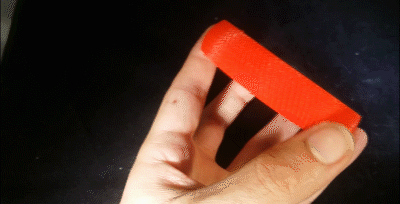 And speaking of Cheetah! This is a new filament that actually has not been released yet. You may have guessed by the name that it’s meant to be faster than the other unique, flexible filaments. As a note, the SD3D team tested this in red, which was supplied as the sample—and it wasn’t yet clear whether or not there will be other colors—which could be rather limiting if not. Pricing information was also not yet available.
And speaking of Cheetah! This is a new filament that actually has not been released yet. You may have guessed by the name that it’s meant to be faster than the other unique, flexible filaments. As a note, the SD3D team tested this in red, which was supplied as the sample—and it wasn’t yet clear whether or not there will be other colors—which could be rather limiting if not. Pricing information was also not yet available.
The SD3D team was apparently very impressed with Cheetah, as they found it offered great performance with ‘extremely clean surface quality’—comparable to that of PLA. While sloped prints were challenging, the team found that the material performed even better than expected.
“Not only is does this material look great, it has some amazing properties,” stated the team.
Without actual elongation or tensile data yet available, SD3D was able to say that it is one, softer than both PCTPE and FlexSolid—and two, ‘only a little more stiff’ than NinjaFlex. Attempting the honeycomb test here, they found that it passed with flying colors, reverting back to shape each time, using a model that was only. 4 walls thick (1.6mm).
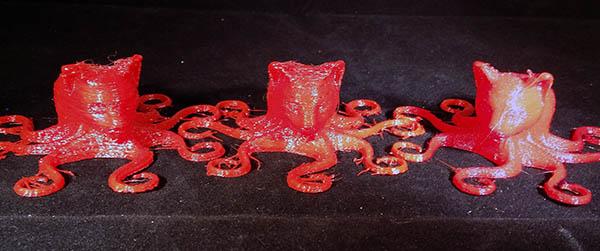 ‘Tricky’ might be a good term for printing issues here as well. Temperature seemed to be a big issue, and that doesn’t bode well for other users.
‘Tricky’ might be a good term for printing issues here as well. Temperature seemed to be a big issue, and that doesn’t bode well for other users.
“The number one issue we seemed to find is that this filament has a very low range of temperature for extrusion. Too cold and the filament will clog and too hot the print will have a very ugly surface quality,” stated SD3D. “This range was difficult for us to dial in because it seemed that even the difference between two printers could vary our settings a bit.”
They experienced issues with oozing, more clogging, and finally after several more tries, decided that the best printing temperature for their TAZ 5 3D printer was 230°-235°C.
Although the filament is promised to run as fast as 75mm/s, the team found the optimum speed to be at 50mm/s, and even there, makes it the fastest out of all the filaments being reviewed here.
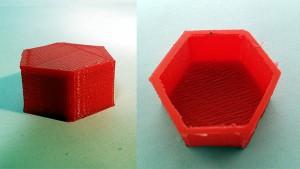 Also on a positive note was that support removal was very easy. Everyone likes to hear that.
Also on a positive note was that support removal was very easy. Everyone likes to hear that.
“While we have only tested a very basic model, the support was very easy and had a very clean underside,” said the team. “We used support with an angle of 53° and above, 10% fill amount, 0.9mm distance in the X/Y direction, and 0.175mm in the Z.”
Heating of the bed was not required and adhesion was ‘great’ during testing. The team was able to run the build plate at 40°C, and removed prints from glass and PEI beds without issue. A full profile for a Cura 0.4mm Nozzle with an e3D setup at .25mm layer heights .ini can be downloaded here.
“The surface quality, along with speed to print, makes this a great material for practical usage,” said SD3D. “The main issue comes with the fact that the price is not yet known. We hope to be able to add this material soon to our list of products available for clients.”
Ending with a filament that has been on the market for a while, details on NinjaFlex by NinjaTek (specifications: strength: 7250 PSI, elongation: 450%, Tg: 74C) will definitely make you take pause—especially knowing that this is a filament SD3D finds difficult to print with. They have found it to offer up hairy prints when retraction settings were less than perfect, and also have noted that models must be printed very slowly. Price is an issue as well. For .75 kg, you will be paying a steep $65.
“…along with a print speed of 25mm/s, this material can end up costing a lot of time and money to use,” states SD3D.
The filament does come in a wide range of colors, however, and on a positive note, SD3D found it to be the softest material, indicating that it would be a good choice (if you can get past excruciating print times and high prices) for items that come into contact with the skin—like bracelets, and more. Printing of complex models is not an option, however, according to SD3D. Supports are a major issue also, and very hard to remove, along with the requirement for slow sprinting speeds.

“As you can see from the photo to the left, a minor change in settings can make a fairly large difference in the print quality. The print on the left was at 235°C, retraction set to a speed of 10mm/s and a distance of 1.5mm. The print on the right was printed at 220°C with retraction set to a speed of 7mm/s and a distance of .5mm.”
“We printed one model on a PEI bed and soon came to regret it. While nylon based materials such as PCTPE will not stick properly to a PEI bed, NinjaFlex stuck so well it destroyed our print,” stated the team. “The entire bottom couple of layers delaminated from the rest of the print even with careful use of a scraper with the bed at room temperature.”
If you are interested, a full profile for a Cura 0.4mm Nozzle with an e3D setup at .25mm layer heights .ini can be downloaded here.
“While NinjaFlex is a lot of fun to play with, the high price tag, slow print speeds, and difficulty to print complex models has made it so that we have not offered the filament for sale to our clients,” states SD3D. “While slightly more soft and flexible than FlexSolid, it is almost always out of the price range and ability to print for client’s models.”
We believe there is a lot of information here to help you on your way if you are looking toward using any of these unique, flexible filaments. The reviews are comprehensive and offer great points regarding each material, which hopefully will assist you greatly in terms of specific applications or projects you may be involved with.
“All four materials can have a good surface quality after dialing in your settings, but NinjaFlex is definitely the most difficult to print. PCTPE, FlexSolid and Cheetah all seem to to have the ability to print support material without too damaging of results, with Cheetah leaving us with a lot to be excited about,” stated SD3D in conclusion.
“We have always found that flexible filaments are some of the hardest unique materials to print fast in high quality. This is why we are very hopeful to offer Cheetah soon to our clients.”
And offering even more tips for your 3D printing projects, SD3D has also just released their free A-Z 3D Printing Handbook recently. Also written by Sean Aranda, it’s free for download or with an email subscription, as well as being available for purchase on Amazon. The handbook covers 26 unique 3D printing terms and tutorials, with every category covered. Did these filament reviews help you with any impending projects or materials purchases? Discuss in the SD3D Filament Review forum over at 3DPB.com.
Subscribe to Our Email Newsletter
Stay up-to-date on all the latest news from the 3D printing industry and receive information and offers from third party vendors.
Print Services
Upload your 3D Models and get them printed quickly and efficiently.
You May Also Like
3D Printing News Briefs, July 2, 2025: Copper Alloys, Defense Manufacturing, & More
We’re starting off with metals in today’s 3D Printing News Briefs, as Farsoon has unveiled a large-scale AM solution for copper alloys, and Meltio used its wire-laser metal solution to...
3DPOD 260: John Hart on VulcanForms, MIT, Desktop Metal and More
John Hart is a Professor at MIT; he´s also the director of the Laboratory for Manufacturing and Productivity as well as the director of the Center for Advanced Production Technologies....
3D Printing News Briefs, June 28, 2025: Defense Accelerator, Surgical Models, & More
In this weekend’s 3D Printing News Briefs, 3YOURMIND was selected to join an EU Defense Accelerator, and PTC has announced model-based definition (MBD) capabilities within Onshape. Finally, a study out...
EOS in India: AM’s Rising Star
EOS is doubling down on India. With a growing base of aerospace startups, new government policies, and a massive engineering workforce, India is quickly becoming one of the most important...


